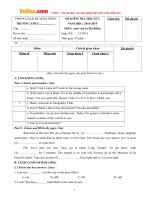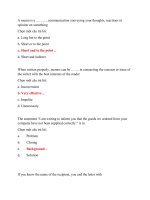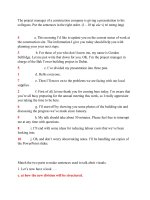Đáp án môn Tiếng Anh thương mại EHOU Đại học Mở (đầy đủ)
Bạn đang xem bản rút gọn của tài liệu. Xem và tải ngay bản đầy đủ của tài liệu tại đây (238.61 KB, 22 trang )
<span class="text_page_counter">Trang 2</span><div class="page_container" data-page="2">
<b>TIẾNG ANH THƯƠNG MẠI - EN51</b>
<i>Hướng dẫn cách tra đáp án: Những câu hỏi chung chung thì anh chị tra cứu bằng đáp án cho nhanh (phím tắt CTRL + F)</i>
<i>Có nhiều đáp án giống nhau, hoặc trùng nhau, nhưng khác câu hỏi, anh chị đọc kỹ câu hỏi.</i>
<i>Chúc anh chị thi tốt!</i>
<small>1.A letter of complaint usually consists of5 parts</small>
<small>3 parts4 parts6 parts</small>
<small>To, From, Date, , and Message sectionsFrom, Date, , and Message sectionsTo, Date, , and Message sectionsTo, From, Date, and Message sections4.A memo contains</small>
<small>To, From, Date, Subject Headings, and Message sectionsFrom, Date, , and Message sections</small>
<small>To, Date, , and Message sectionsTo, From, Date, and Message sections5.An application letter is</small>
<small>To apply for a jobTo complain</small>
</div><span class="text_page_counter">Trang 3</span><div class="page_container" data-page="3"><small>To make an enquiryTo request an action</small>
<small>6.An application letter is divided intoFour paragraphs</small>
<small>Five paragraphsThree paragraphsTwo paragraphs</small>
<small>7.How many types of email are there?</small>
<small>8.If you begin the letter with Dear Sir/Madam, at the end of your letter you should include the closing phrase:</small>
<small>Yours faithfullyBest wishesBests regardsYours sincerely</small>
<small>9.In a letter of complaint, we describe the situation inBackground</small>
<small>10.Reports are matter of fact and to the point. Language is therefore ……Neutral and factual</small>
<small>Neutral or factualSubjective</small>
<small>11.The expression “Hi/Hello + name ...……….” in an email is an informalSalutation</small>
<small>Conclusion</small>
</div><span class="text_page_counter">Trang 4</span><div class="page_container" data-page="4"><small>12.The expression “I am writing to……….” in an email is in theOpening</small>
<small>13.The 'From' section in a memo containsThe name of the sender</small>
<small>The dateThe main idea</small>
<small>The name of the receiver</small>
<small>14.The heading segment should include</small>
<small>To, From, Date, SubjectFrom, Date,</small>
<small>To, Date,To, From, Date</small>
<small>15.The heading segment should includeTo, From, Date,</small>
<small>From, Date,To, Date,To, From, Date</small>
<small>16.The 'To' section in a memo contains</small>
<small>The name of the receiverThe date</small>
<small>The main idea</small>
<small>The name of the sender</small>
<small>17.We clearly state the purpose of communication in theSubject line</small>
<small>“Date” section“From” section“To” section</small>
</div><span class="text_page_counter">Trang 5</span><div class="page_container" data-page="5"><small>18.We explain what the facts mean in</small>
<small>19.We suggest what action(s) should be done inRecommendations</small>
<small>20.When we received a complaint letter, if the cause of the problem were beyond our responsibility, we could</small>
<small>Reject the complaintAccept the complaintDo nothing</small>
<small>Ignore the complaint</small>
<small>21.When written properly, memos can be ……. in connecting the concern or issue of the writer with the best interests of the reader</small>
<small>Very effectiveImpoliteInconvenientUnnecessary</small>
<small>22.Yours sincerely is ……. of the business letter</small>
<small>At the endAt the beginningIn the middleNot necessary</small>
<b>In a letter of complaint, we describe what should be done to solve the problem in</b>
a. Closing
</div><span class="text_page_counter">Trang 6</span><div class="page_container" data-page="6"><b>b. Solution </b>
c. Problemd. Background
<b>The statement “I look forward to receiving your explanation of these matters.” is in</b>
Chọn một câu trả lời:a. Background
<b>b. Closing</b>
c. Problemd. SolutionPhản hồi
The corect answer is : Closing
Reference : Textbook: Writing Business English – Lesson 2
<b>An application letter is</b>
Chọn một câu trả lời:a. To request an action
<b>b. To apply for a job </b>
c. To complain
d. To make an enquiryPhản hồi
The corect answer is: To apply for a job.
Reference : Textbook: Writing Business English – Lesson 1
<b>A letter of complaint usually consists of</b>
Chọn một câu trả lời:a. 3 parts
<b>b. 5 parts</b>
c. 4 partsd. 6 partsPhản hồi
The corect answer is: 5 partsReference : Lecture 1
<b>In a letter of complaint, we describe what is expected from the recipient</b>
<b>in</b>
</div><span class="text_page_counter">Trang 7</span><div class="page_container" data-page="7">Chọn một câu trả lời:
<b>a. Closing</b>
b. Problemc. Solutiond. BackgroundPhản hồi
The corect answer is : Closing
Reference : Textbook: Writing Business English – Lesson 2
<b>The statement “I am writing to inform you that the goods we </b>
<b>ordered from your company have not been supplied correctly.” is in</b>
Chọn một câu trả lời:a. Problem
b. Closing
<b>c. Background </b>
d. SolutionPhản hồi
The corect answer is : Background
Reference : Textbook: Writing Business English – Lesson 2
<b>If you know the name of the recipient, you end the letter with</b>
Chọn một câu trả lời:a. Best wishes
b. Yours faithfullyc. Bests regards
<b>d. Yours sincerely </b>
Phản hồi
The corect answer is : Yours sincerely
Reference : Textbook: Writing Business English – Lesson 1
<b>In a letter of complaint, we describe the situation in</b>
Chọn một câu trả lời:a. Solution
<b>b. Background </b>
c. Problemd. ClosingPhản hồi
The corect answer is : Background Reference : Textbook: Writing Business English – Lesson 2
</div><span class="text_page_counter">Trang 8</span><div class="page_container" data-page="8"><b>If you begin the letter with Dear Sir/Madam, at the end of your letter you should include the closing phrase:</b>
Chọn một câu trả lời:a. Best wishes
b. Yours sincerely
<b>c. Yours faithfully</b>
d. Bests regardsPhản hồi
The corect answer is: Yours faithfully
Reference : Textbook: Writing Business English – Lesson 1
<b>If the letter is going to someone whose name you know, you can begin with</b>
The corect answer is : Dear Mr. / Ms. Brown.
Reference : Textbook: Writing Business English – Lesson 1
<b>In a letter of complaint, we describe the cause and effect in</b>
Chọn một câu trả lời:a. Warning
b. Backgroundc. Solution
<b>d. Problem</b>
Phản hồi
The corect answer is: Problem
Reference : Textbook: Writing Business English – Lesson 2
<b>Paragraph 1 in a letter of request is to</b>
Chọn một câu trả lời:
a. Cover relevant background information and detailsb. Reiterate action and/or thank
c. Provide contact information
<b>d. Request specific information or action </b>
Phản hồi
</div><span class="text_page_counter">Trang 9</span><div class="page_container" data-page="9">The corect answer is : Request specific information or action Reference : Textbook: Writing Business English – Lesson 4
<b>Paragraph 2 in a letter of request is to</b>
Chọn một câu trả lời:
a. Reiterate action and/or thank
b. Request specific information or action
<b>c. Cover relevant background information and details </b>
d. Provide contact informationPhản hồi
The corect answer is : Cover relevant background information and detailsReference : Textbook: Writing Business English – Lesson 4
<b>The expression “Thank you for your letter of … regarding / concerning / in connection with…” is used to</b>
Chọn một câu trả lời:a. Reject the complaint
<b>b. Acknowledge receipt of a complaint letter </b>
c. Apologize for the error or faultd. Regret the dissatisfactionPhản hồi
The corect answer is : Acknowledge receipt of a complaint letterReference : Textbook: Writing Business English – Lesson 3
<b>The expression “I’m writing from __________ and I was wondering if you could…” is used to</b>
Chọn một câu trả lời:
a. Provide contact information
<b>b. Request specific information or action </b>
c. Cover relevant background information and detailsd. Reiterate action and/or thank
a. Request specific information or action
b. Cover relevant background information and details
<b>c. Provide contact information </b>
d. Reiterate action and/or thank
</div><span class="text_page_counter">Trang 10</span><div class="page_container" data-page="10">Phản hồi
The corect answer is: Provide contact information
Reference : Textbook: Writing Business English – Lesson 4
<b>Paragraph 1 in an application letter is</b>
Chọn một câu trả lời:
a. To state your enthusiasm and interestb. To describe your practical work experience
<b>c. To state that you are applying for the job</b>
d. To ask for an interviewPhản hồi
The corect answer is: To state that you are applying for the jobReference : Textbook: Writing Business English – Lesson 1
<b>Paragraph 2 in an application letter is</b>
Chọn một câu trả lời:
<b>a. To describe your practical work experience</b>
b. To state your enthusiasm and interestc. To state that you are applying for the jobd. To ask for an interview
The corect answer is: Four paragraphs
Reference : Textbook: Writing Business English – Lesson 1
<b>Business letters are usually quite formal in style, so we should.</b>
Chọn một câu trả lời:
<b>a. Avoid writing sentences that are too long</b>
b. Write sentences that include complicated or unnecessary language
</div><span class="text_page_counter">Trang 11</span><div class="page_container" data-page="11">c. Use verbs in passive formsd. Use contractions
b. The name of the receiver
<b>c. The name of the sender </b>
d. The datePhản hồi
The corect answer is: The name of the sender
Reference : Textbook: Writing Business English – Lesson 7
<b>We clearly state the purpose of communication in the</b>
Chọn một câu trả lời:a. “To” section
b. “Date” section
<b>c. Subject line </b>
d. “From” sectionPhản hồi
The corect answer is : Subject lin
Reference : Textbook: Writing Business English – Lesson 7
<b>We write memos with purpose and make that purpose known in the</b>
Chọn một câu trả lời:a. Second paragraphb. Fourth paragraph
<b>c. First paragraph </b>
d. Third paragraphPhản hồi
The corect answer is : First paragraph.
Reference : Textbook: Writing Business English – Lesson 7
<b>A memo</b>
Chọn một câu trả lời:a. Can’t be signedb. Should be signed
</div><span class="text_page_counter">Trang 12</span><div class="page_container" data-page="12"><b>c. Does not need to be signed </b>
d. Must be signedPhản hồi
The corect answer is: Does not need to be signed
Reference : Textbook: Writing Business English – Lesson 7 .
<b>There are ……. basic reasons to write a memo</b>
Chọn một câu trả lời:
<b>a. 3 </b>
b. 5c. 2d. 4Phản hồi
The corect answer is: 3
Reference : Textbook: Writing Business English – Lesson 7
<b>A memo contains</b>
Chọn một câu trả lời:
a. From, Date, , and Message sections
<b>b. To, From, Date, Subject Headings, and Message sections </b>
c. To, Date, , and Message sectionsd. To, From, Date, and Message sectionsPhản hồi
The corect answer is : To, From, Date, , and Message sectionsReference : Textbook: Writing Business English – Lesson 7
<b>The ‘To’ section in a memo contains</b>
Chọn một câu trả lời:a. The date
b. The main idea
<b>c. The name of the receiver </b>
d. The name of the senderPhản hồi
The corect answer is: The name of the receiver
Reference : Textbook: Writing Business English – Lesson 7
<b>A memo is a ………..communication conveying your thoughts, reactions or opinion on something</b>
Chọn một câu trả lời:a. Short or to the point
</div><span class="text_page_counter">Trang 13</span><div class="page_container" data-page="13">b. Short and indirectc. Long but to the point
<b>d. Short and to the point </b>
Phản hồi
The corect answer is : Short and to the point
Reference : Textbook: Writing Business English – Lesson 7 .
<b>The ‘Subject’ section in a memo contains</b>
Chọn một câu trả lời:a. The date
b. The name of the senderc. The name of the receiver
<b>d. The main idea </b>
Phản hồi
The corect answer is: The main idea
Reference : Textbook: Writing Business English – Lesson 7
<b>……make a memo lengthy</b>
Chọn một câu trả lời:a. Usually
<b>b. Never </b>
c. Alwaysd. OftenPhản hồi
The corect answer is Never
Reference : Textbook: Writing Business English – Lesson 7
<b>We should close the memo with a ………..ending that states what actions we want the reader to take</b>
Chọn một câu trả lời:a.
Warningb. Unfriendlyc. Threatening
<b>d. Friendly </b>
Phản hồi
The corect answer is: Friendly
</div><span class="text_page_counter">Trang 14</span><div class="page_container" data-page="14">Reference : Textbook: Writing Business English – Lesson 7
<b>The expression “Hope to hear from you soon .” in an email is an informal</b>
Chọn một câu trả lời:a. Opening
<b>b. Conclusion</b>
c. Headlined. SalutationPhản hồi
The corect answer is : Conclusion
Reference : Textbook: Writing Business English – Lesson 5
<b>The Subject Line in an email should be</b>
Chọn một câu trả lời:a. Informal
b. Long
<b>c. Short</b>
d. IndirectPhản hồi
The corect answer is : Short
Reference : Textbook: Writing Business English – Lesson 5
<b>The expression “Just a quick note to……….” in an email is an informal</b>
Chọn một câu trả lời:a. Salutation
b. Closing
<b>c. Opening</b>
d. HeadlinePhản hồi
The corect answer is : Opening
Reference : Textbook: Writing Business English – Lesson 5
<b>The expression “Looking forward to your reply……….” in an email is in the</b>
Chọn một câu trả lời:
<b>a. Conclusion</b>
b. Salutationc. Openingd. Headline
</div><span class="text_page_counter">Trang 15</span><div class="page_container" data-page="15">Phản hồi
The corect answer is : Conclusion
Reference : Textbook: Writing Business English – Lesson 5
<b>How many types of email are there?</b>
Chọn một câu trả lời:a. 3
b. 1
<b>c. 2 </b>
d. 4Phản hồi
The corect answer is : 2
Reference : Textbook: Writing Business English – Lesson 5
<b>One of the advantages of emails over normal “snail- mail” letters is that they are …..</b>
Chọn một câu trả lời:a. Slow but direct
<b>b. Quick and direct </b>
c. Quick or directd. Quick and indirectPhản hồi
The corect answer is Quick and direct
Reference : Textbook: Writing Business English – Lesson 5
<b>The Subject Line in an email is the</b>
Chọn một câu trả lời:
<b>a. Headline</b>
b. Salutationc. Closingd. OpeningPhản hồi
The corect answer is : Headline
Reference : Textbook: Writing Business English – Lesson 5
<b>The expression “Hi/Hello + name ………….” in an email is an informal</b>
Chọn một câu trả lời:a. Opening
<b>b. Salutation</b>
c. Conclusion
</div><span class="text_page_counter">Trang 16</span><div class="page_container" data-page="16">d. HeadlinePhản hồi
The corect answer is : Salutation
Reference : Textbook: Writing Business English – Lesson 5
<b>The expression “Yours sincerely.” in an email is a very formal and rarely used</b>
Chọn một câu trả lời:a. Salutation
b. Headline
<b>c.Close </b>
d. OpeningPhản hồi
The corect answer is : Close Reference :
Reference : Textbook: Writing Business English – Lesson 5
<b>The expression “I am writing to……….” in an email is in the</b>
Chọn một câu trả lời:a. Salutation
b. Headline
<b>c. Opening</b>
d. ClosingPhản hồi
The corect answer is : Opening
Reference : Textbook: Writing Business English – Lesson 5
<b>When we write a report, presentation and style are</b>
Chọn một câu trả lời:
<b>a. Important </b>
b. Not importantc. Useless
d. Not necessaryPhản hồi
The corect answer is : Important
Reference : Textbook: Writing Business English – Lesson 9
<b>When writing a memo, we should keep paragraphs ….</b>
</div><span class="text_page_counter">Trang 17</span><div class="page_container" data-page="17">Chọn một câu trả lời:a. Informal
b. Formal
<b>c. Short </b>
d. LongPhản hồi
The corect answer is : Short
Reference : Textbook: Writing Business English – Lesson 9
<b>The expression “I recommend that ….” is used in</b>
Chọn một câu trả lời:a. Conclusions
<b>b. Recommendations </b>
d. ProceedingsPhản hồi
The corect answer is : Recommendations
Reference : Textbook: Writing Business English – Lesson 9
<b>Reports are matter of fact and to the point. Language is therefore ……</b>
Chọn một câu trả lời:a. Informal
<b>b. Neutral and factual </b>
c. Neutral or factuald. Subjective
Phản hồi
The corect answer is : Neutral and factual
Reference : Textbook: Writing Business English – Lesson 9
<b>We explain what the facts mean in</b>
Chọn một câu trả lời:a.
Recommendationsb. Findings
c. Proceedings
<b>d. Conclusions </b>
</div><span class="text_page_counter">Trang 18</span><div class="page_container" data-page="18">b. An address
<b>c. A title </b>
d. A namePhản hồi
The corect answer is : A title
Reference : Textbook: Writing Business English – Lesson 9
<b>We suggest what action(s) should be done in</b>
Chọn một câu trả lời:
<b>a. Recommendations </b>
Conclusionsc. Proceedingsd. FindingsPhản hồi
The corect answer is: Recommendations
Reference : Textbook: Writing Business English – Lesson 9
<b>There should be ….. sub-sections in a report</b>
Chọn một câu trả lời:
<b>a. 5 </b>
b. 4c. 2d. 3Phản hồi
The corect answer is : 5
Reference : Textbook: Writing Business English – Lesson 9
<b>We explain what the report is about in</b>
Chọn một câu trả lời:a. Conclusions
b. Findings
</div><span class="text_page_counter">Trang 19</span><div class="page_container" data-page="19">b. Can’t
<b>c. Should</b>
d. Mustn’tPhản hồi
The corect answer is : Should
Reference : Textbook: Writing Business English – Lesson 9
<small>The expression “Hi/Hello + name ...……….” in an email is an informalChọn một câu trả lời:</small>
<small>a. Headlineb. Opening</small>
<small>c. Salutation</small>
<small>d. Conclusion</small>
<small>If the letter is going to someone whose name you do not know, it starts withChọn một câu trả lời:</small>
<small>a. Dear Mr. John/ Ms. Marry, ……</small>
<small>b. Dear Sir or Dear Madam or Dear Sir/Madam</small>
<small>c. Dear Mr. / Ms. Brown</small>
<small>d. Dear John/ Marry</small>
</div><span class="text_page_counter">Trang 20</span><div class="page_container" data-page="20"><b>If your memo is longer than a page, you may want to include a separate …</b>
Chọn một câu trả lời:a. Closing segment
<b>b. Summary segment </b>
c. Discussion segmentd. Opening segmentPhản hồi
The corect answer is : Summary segment
Reference : Textbook: Writing Business English – Lesson 7
<b>The heading segment should include</b>
Chọn một câu trả lời:a. From, Date,
b. To, Date,
c. To, From, Date
<b>d. To, From, Date, Subject </b>
b. Impolitec. Unnecessary
<b>d. Very effective </b>
Phản hồi
The corect answer is : Very effective
Reference : Textbook: Writing Business English – Lesson 7
<b>Dear Sir/Madam is the salutation ……. of the business letter</b>
Chọn một câu trả lời:a. At the end
b. Not necessary
<b>c. At the beginning </b>
d. In the middlePhản hồi
The corect answer is : At the beginning
</div>








